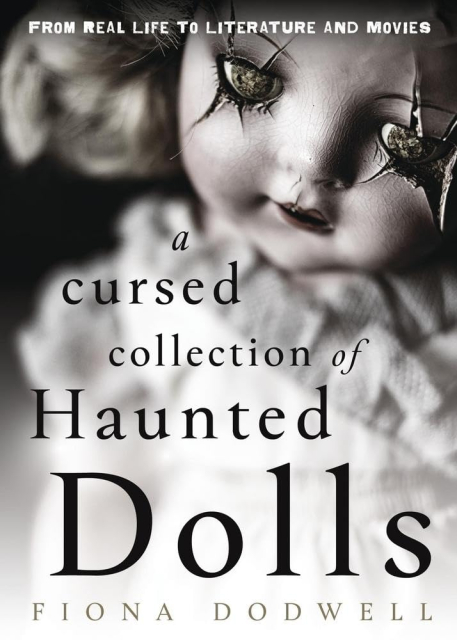
Reviewed by Fred Andersson
I’ve always had a problem with dolls (and puppets) in horror. They don’t scare me – instead they annoy me. Like clowns, they’re a meme that makes me want to rip their heads off, throw them in the bin, and move on with my boring life. And yet … clearly something in me reacts. Otherwise, why the sudden urge to decapitate the poor things?
Enter Fiona Dodwell’s A Cursed Collection of Haunted Dolls, which arrived just in time to test my prejudice - and, if I’m honest, my patience with the little bastards.
If you want a clear, readable introduction to the whole haunted doll phenomenon, this is it. Dodwell explains what a haunted doll is, then takes us through the usual suspects (Robert, Annabelle, Peggy, Harold) and plenty of lesser-known ones. She starts with a short cultural background - Egyptian shabtis, Victorian mourning dolls (did they really exist, though?), ventriloquism’s ghostly past, and the weird charm of Frozen Charlottes - written in a brisk, fact-filled style that’s perfect for ruining dinner party conversations.
The book’s structure is simple and works well: an introduction, chapters on famous and lesser-known dolls, two personal case studies (Edna and Bonnie), a set of interviews, and then surveys of dolls in film and literature. It’s meant as a tour, not a deep thesis - and if you read it that way, it does the job.
The interviews are the best part. This is where the book comes alive. We meet collectors and investigators who actually live with these objects and take them seriously, without losing their sense of humor. They can say things like “some hauntings feel positive” while also warning you not to surprise your partner or pets with a “spirited” toy unless you like sleeping on the sofa. (“One person’s new bestie can be another person’s literal nightmare.”)
There are great cameos from people like investigator Miki York, who links certain dolls to diary entries, filming glitches, and equipment trouble - and from parapsychologist Evelyn Hollow, who cools things down with theory and scepticism. Her term “spooky capitalism” for today’s haunted-object market is spot on.
The pop-culture section is another highlight. The film chapter doesn’t just tick off Chucky and Annabelle; it digs into tech-age fears (the Child’s Play reboot - criminally underrated, in my view), AI friendship gone wrong (M3GAN), and even curveballs like Osgood Perkins slow and creepy Longlegs, which earns its place through the dollmaker angle. I’m also happy to see Dolly Dearest mentioned, a stiff but cozy Child’s Play ripoff that in some territories was marketed as Child’s Play 4: Dolly Dearest! The literature section ranges from young adult staples to Ellen Datlow’s anthologies and Adam Nevill’s The House of Small Shadows - perfect if you like your horror damp, dusty, and full of glass-eyed doll weirdos.
The “lesser-known” chapter is like catnip: Okiku with her ever-growing hair, Ruby who induces nausea, Charley in Massachusetts, and Letta Me Out - complete with panicked animals and a “tried to sell it but physically couldn’t leave the car” moment. Dodwell tells these stories clearly, without overselling them.
The tone throughout is friendly and fast. You can read several whole chapters on your commute. There’s even a tongue-in-cheek disclaimer about using illustrations instead of real photos because certain dolls “may result in bad luck.” I love that kind of theatrical touch - and it gave me an excuse to google the real ones and, as the conspiracy crowd says, “do my own research.”
What I wanted more was balance. Not a hard-nosed debunking, but a bit more switching between witness stories, cultural background, and research method. Dodwell has all the right ingredients - theories about imprints, curses, and conduits; interviews that raise questions about evidence and documentation - but the framing leans toward acceptance. A small “how would we test this?” box or side note comparing theories would have been fun.
This lack shows most in the personal chapters. Dodwell’s sessions with Bonnie, using apps like Spirit Talker and the Alice Box, are engaging because you can feel her curiosity. Of course you’d want to test it. This is also where the author could pause and unpack things like app reliability and the power of suggestion. To her credit, Dodwell admits the tools are controversial - but a short note on method would make those scenes even stronger.
The one real wobble is the foreword, which comes in loud from the world of demonology - all Latin banishments and “possessed Christmas display” energy. It’s fun, but tonally far from Dodwell’s own calm, thoughtful approach.
So - do I still want to rip a doll’s head off after reading this? Honestly, less so. The sheer range of stories makes the topic feel less like a joke and more like a cultural weather map: Grief objects, horror marketing, internet folklore, and our need to give agency to those glass eyes. The book works best when it treats dolls as reflections of us first, haunted vessels second.
In short: A Cursed Collection of Haunted Dolls is an easy, entertaining read with a surprisingly human touch - and far more dolls than I ever thought existed in one field. As a reader, I wanted more balance; as a researcher, I’m glad to now have a compact guide to a weird, very online corner of folklore. It’s a warmly recommended if you’re doll-curious but not yet doll-possessed. (And yes, ventriloquist dummies remain the creepiest. Always have. Always will).
At one point I wrote, “If every haunted doll is haunted, what’s left to investigate?” I deleted that because it felt unfair - but it still feels like the right question. Dodwell’s book doesn’t answer it, but it gives you plenty to explore next.

